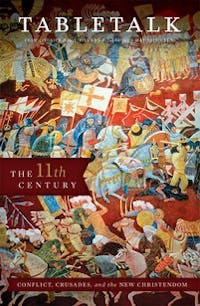
Request your free, three-month trial to Tabletalk magazine. You’ll receive the print issue monthly and gain immediate digital access to decades of archives. This trial is risk-free. No credit card required.
Try Tabletalk NowAlready receive Tabletalk magazine every month?
Verify your email address to gain unlimited access.
Anselm held the position of archbishop of Canterbury from 1093 to 1109. A Benedictine monk, philosopher, and theologian, he stands as one of the most significant thinkers in the history of the Western church.
His influence is not due to the sheer volume of his writings but to his ability to expound profound subjects biblically and thoughtfully in just a few words. In general, the assumption exists that to make a significant contribution to the body of literature that shapes scholarly thought requires the production of massive tomes. Anselm’s impact completely overthrows this notion.
His thought has had far-reaching consequences, even to this day. Anselm, more than any of the other thinkers of antiquity, plumbed the depths of the substitutionary, satisfaction view of the atonement. In his book Cur Deus Homo (Why the Godman?), he saw the work of Christ on the cross as an act of propitiation by which Jesus satisfied the demands of God’s justice. Neither the Devil nor human desires were satisfied, but God Himself. Neither was the wrath of God satisfied so much as His justice, which Anselm defined as His righteousness or rectitude.
Paul writes that in the drama of justification, through the work of Christ, God is both “just and the justifier” (Rom. 3:26). He labors the point that in the atoning work of Jesus God does not simply overlook the sin of fallen humanity and give us a pass. Rather, He ensures His own character is not compromised and thereby establishes His justice. God requires the payment by Christ, as our substitute, to maintain His justice. The cross is simultaneously God’s foremost manifestation of justice and grace. His justice is displayed in that Jesus pays for sin, and His grace is seen in that redemption is offered to us through Jesus’ work. It is the perfect Mediator who satisfies God’s justice and saves God’s people.
This truth impacted not only the church’s thinking about the atonement but also, unfortunately, the Roman Catholic Church’s understanding of the Mass as a repetition of the atoning work of Christ. Rome twisted Anselm’s thought to make it fit its sacerdotal system of salvation, using his words in ways Anselm never intended. Thus, the Mass is considered an unbloody sacrifice involving satisfaction.
After Cur Deus Homo, the second work for which Anselm is famous is a little book called Monologion. In this book, he seeks to answer the question of the relationship between faith and reason. He argues that since revelation is at the foundation of all truth, the Christian begins by believing and trust ing in God’s revelation. In approaching revelation, the Christian does not abandon the intellect. Instead, he grasps the rational coherence of revelation. This is the ongoing task of the Christian thinker, the starting point of faith. We do not come to a rational understanding of God’s revelation before we are able to believe; rather, we must first put our trust in that revelation in order to see its coherence. Anselm’s famous slogan was Credo ut intelligam (“I believe in order that I may understand”).
In this little book, following the process of faith seeking understanding, Anselm works out a cosmological argument for the existence of God. The essence of this argument is that only God, in His creative power, gives us sufficient reason for the existence of the universe. But the cosmological argument has been formulated in many ways and times by many different people.
What makes Anselm stand out in the history of philosophy and apologetics is his extraordinary argument set forth in his third book, Proslogion. Anselm desired to give a simple and quick proof for the existence of God based on the nature of God’s being. Hence, this proof has been called the ontological argument for the existence of God. It flows from and rests upon an understanding of God’s being.
Again basing his assumptions on the revelation by which God has made Himself known to all people, Anselm argues that every person has some idea of God. The idea that we have of God is not that of a mere mythical structure, but of a God who truly exists. There is a sense in which the very idea of God carries with it the idea of His existence. In an interesting twist of words, Anselm stated the argument this way: God is that than which nothing greater can be conceived. Since we conceive of God, we must conceive of Him as existing in reality and not just in the mind. Anselm understood that the mind is able to consider things that do not exist, but the idea of God being that than which no greater can be conceived, cannot be conceived as nonexistent. If we are conceiving of God simply as a formal concept but not attributing to Him existence, we have not reached the idea of Anselm’s God. This is because there would still be a being greater than a being that exists only in the mind and not in reality. That being, than which no greater can be conceived, must exist in reality as well as the mind or it is not that being than which no greater can be conceived.
This is the kind of argument that has given philosophers Excedrin headaches for centuries, but the impact of it remains powerful, as does the impact of the body of work of the ancient archbishop of Canterbury.
